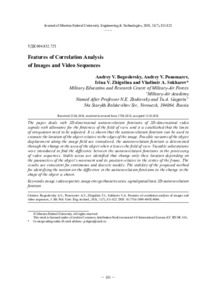Особенности корреляционного анализа изображений и видеопоследовательностей
Скачать файл:
URI (для ссылок/цитирований):
https://elib.sfu-kras.ru/handle/2311/109151Автор:
Богословский, А.В.
Пономарев, А.В.
Жигулина, И.В.
Сухарев, В.А.
Bogoslovsky, Andrey V.
Ponomarev, Andrey V.
Zhigulina, Irina V.
Sukharev, Vladimir A.
Дата:
2018-11Журнал:
Журнал Сибирского федерального университета. Техника и технологии. Journal of Siberian Federal University. Engineering & Technologies: 2018 11 (7)Аннотация:
В работе рассмотрены двумерные автокорреляционные функции двумерных видеосигналов
с учетом финитности поля зрения и установлена необходимость корректировки
пределов интегрирования. Показано, что по функции автокорреляции можно оценить
расположение объекта относительно краев изображения. Рассмотрены возможные
варианты смещения объекта по полю изображения, определена функция автокорреляции
через изменение площади объекта при выходе его за пределы поля изображения.
Введены замены переменных для нахождения разности автокорреляционных функций
при обработке видеопоследовательностей. Выделены стабильные области, которые
меняют только свое расположение в зависимости от параметров движения объекта
и его положения относительно центра кадра. Проведено согласование результатов для
непрерывных и дискретных моделей. Показана устойчивость предлагаемого метода
идентификации движения по разности автокорреляционных функций к изменению
формы объекта The paper deals with 2D-dimensional autocorrelation functions of 2D-dimensional video
signals with allowance for the finiteness of the field of view, and it is established that the limits
of integration need to be adjusted. It is shown that the autocorrelation function can be used to
estimate the location of the object relative to the edges of the image. Possible variants of the object
displacement along the image field are considered, the autocorrelation function is determined
through the change in the area of the object when it leaves the field of view. Variable substitutions
were introduced to find the difference between the autocorrelation functions in the processing
of video sequences. Stable areas are identified that change only their location depending on
the parameters of the object’s movement and its position relative to the center of the frame. The
results are consistent for continuous and discrete models. The stability of the proposed method
for identifying the motion on the difference in the autocorrelation functions to the change in the
shape of the object is shown

